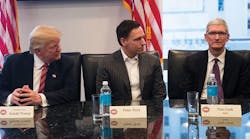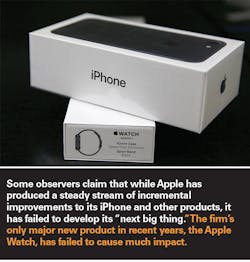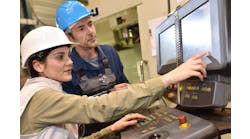“I’m going to get Apple to start making their computers and their iPhones on our land, not in China. How does it help us when they make it in China?”
After his victory last March in the Super Tuesday primaries, that was the message from candidate Donald J. Trump, who also had criticized dozens of other companies for moving, or planning to move, production offshore from the United States.
While Trump criticized Apple a number of times during the campaign, he took a very different tone at a December 14 meeting with a bevy of Silicon Valley giants, including Apple CEO Tim Cook, Amazon CEO Jeff Bezos and Alphabet’s Larry Page. “I’m here to help you folks do well,” Trump said at the start of the meeting, according to a Bloomberg report.
Like it or not, Apple may find itself at the center of a debate concerning the future of American manufacturing. Over the past few decades, many manufacturers have moved jobs from the United States to low-cost countries. In business circles, it has been accepted that this was an inevitable evolution and that the future of the United States lay mainly in the service sector, a transition from low-paying brawn jobs to high-paying brain jobs.
While it originally manufactured its computers in the U.S., Apple long ago moved to a system where it designed its products in the United States but used a network of largely Asian manufacturers, in particular Taiwan-based Foxconn, to produce components and assemble its products ranging from the MacBook and the iPad to the ubiquitous iPhone.
Both the products and the process have been roaring successes, making Apple the most valuable company in the world. For the past two fiscal years, the Cupertino, Calif., firm has had sales exceeding $200 billion annually and net income of $45 to $53 billion. Moreover, the company is sitting on a cash reserve of more than $237 billion.
With a market cap of approximately $640 billion, Apple is much too big to escape the notice of a president who has repeatedly stated his intention to bring manufacturing jobs back to the United States.
Trump isn’t the first president to want Apple to put more manufacturing in the United States. In February 2011, then-President Barack Obama asked the late Steve Jobs why the iPhone couldn’t be made in the U.S. The reply, according to a New York Times report: “Those jobs aren’t coming back.”
When a Times reporter asked a former Apple executive why the company had focused on manufacturing in Asia, the executive said Tim Cook, Apple’s supply chain mastermind, had concluded, “Factories in Asia ‘can scale up and down faster’ and ‘Asian supply chains have surpassed what’s in the U.S.’ The result is that ‘we can’t compete at this point,’ the executive said.”
While Apple does little manufacturing in the U.S., the company has struck back against the notion that it is not a jobs creator. Apple directly employs approximately 66,000 in the U.S., of whom 30,000 are reported to work in Apple stores. But in January 2016, the company pointed out that it was “responsible for creating and supporting 1.9 million jobs in the U.S. alone. Nearly three-quarters of those jobs — over 1.4 million — are attributable to the community of app creators, software engineers and entrepreneurs building apps for iOS, as well as non-IT jobs supported directly and indirectly through the app economy.”
Is Apple Ready to Reshore?
What would it take for Apple to start manufacturing substantial numbers of its products in the United States? Some observers think a deal could be in the works, where Apple reshores some portion of its manufacturing in exchange for repatriation of its substantial profits sitting overseas at a lower tax rate. The company currently has more than $200 billion in overseas accounts. President Trump has suggested a one-time 10% tax rate for these funds. Trump has also promised to substantially lower the U.S. corporate tax rate, among the highest in the developed world at 35%.
Such financial incentives would certainly be needed for Apple to shift production from China. As the New York Times reported in “How China Built ‘iPhone City’ with Billions in Perks for Apple’s Partners,” Foxconn has received more than $1.5 billion from the Chinese government to build its huge factory in Zhengzhou. That factory can produce up to 500,000 iPhones a day. Not only did the local government help finance the factory and roads leading to it, but it “helps cover continuing energy and transportation costs for the operation. It recruits workers for the assembly line. It pays bonuses to the factory for meeting export targets.”
“I can see through political pressure and needing a seat at the table that they may consider moving some element of production or even assembly to the U.S.,” says Peter Bryant, managing partner at Clareo, a business strategy consulting firm. “I think they are going to struggle to do nothing in this area.”
Moving production of iPhones to the U.S. would be not only expensive and difficult but also risky in a number of ways. Experts such as Bryant point out that moving production to the U.S. would increase the cost of the iPhone.
“Apple products are already premium priced,” says Bryant. “I’m not sure there is room to keep jacking the price up. If they have to absorb that price increase, that’s a pretty big margin erosion that shareholders won’t like.”
Higher production costs could lead to less investment in R&D and new technologies over time, worries Gary Pisano, a professor at Harvard Business School. As a result, he warns, “they hurt themselves and they hurt the U.S. economy.”
Rather than “using the bully pulpit to push companies to put a factory in the U.S.,” said Pisano, the U.S. should bolster its trade enforcement policies so U.S. firms are not forced either to manufacture in other countries or to hand over their intellectual property. He said manufacturers would also be more likely to invest in the U.S. if the country adopted “rational” tax policies, more investment in jobs training and improved regulatory schemes that promote, for example, faster permitting of facilities and processes. Overall, he said, the U.S. needs to work to create an industrial ecosystem where manufacturers want to locate and where “high wage, high productivity” jobs are created.
“I don’t want to make things the Chinese make,” said Pisano. “I want to make things the Chinese can’t because our productivity and our skill base is so much higher.”
Alan Tonelson, an economist and trade expert, says Foxconn’s recent revelation that it was considering investing $7 billion to bring a flat panel display factory to the U.S. undercuts arguments that the electronics supply chain could not be brought here.
He notes that Foxconn is considering creating 30,000 to 50,000 jobs in America and that it has already announced plans, as AFP reported, for a “$40 million investment in a facility in Pennsylvania to build precision tools and develop a robotics program.”
“That sure sounds like supply chain stuff to me,” Tonelson wrote in his RealityChek blog.
Apple will consider a complex web of factors before committing to substantial U.S. manufacturing. China offers an established supply chain, financial support and abundant manpower, but wages are rising in China, eroding its price advantages. The labor component of the price of Apple products is almost certain to diminish as Foxconn and other manufacturing partners employ more automation in the production and assembly of products. And China can be an unpredictable partner with U.S. businesses. China has blocked Apple’s iBooks and Movies online stores and recently ordered the removal of the New York Times app from the Apple store.
Still, China offers a huge and growing market for U.S. companies such as Apple and retaliation by the Chinese government for a withdrawal of manufacturing by Foxconn would surely damage Apple from both a manufacturing and retail standpoint.
Waiting for the Next Big Thing
Pressure from the Trump administration is not the only challenge facing Apple. Sales for its latest fiscal year, which ended September 24, 2016, fell to $215.6 billion from $233.7 billion in fiscal 2015. There is concern that the market is increasingly saturated for mobile phones such as the iPhone, which accounts for 60% of Apple sales. Moreover, observers point to differentiation diminishing between that iconic device and competitors’ phones.
That leads to another criticism – that in the post-Steve Jobs era, Apple has lost some of its innovation edge. Some observers claim that while Apple has produced a steady stream of incremental improvements to its iPhone and other products, it has failed to develop its “next big thing.” The firm’s only major new product in recent years, the Apple Watch, has failed to cause much impact. Some say the reason for this lies with CEO Tim Cook.
Tech entrepreneur and educator Steve Blank, for instance, wrote on his blog that while Jobs was a disruptive visionary, Cook is a master of execution.
“The problem is that a supply chain CEO who lacks a passion for products and has yet to articulate a personal vision of where…Apple will go is ill equipped to make the right organizational, business model and product bets to bring those to market,” Blank wrote.
Apple’s innovation suffered the first time Jobs left the company, notes George Haley, a professor of Marketing and director of the Center for International Industry Competitiveness at the University of New Haven. But Haley says the problem lies less with Cook than it does with Apple’s decision to outsource its manufacturing from the U.S. He says over time, outsourcing from its own factories to suppliers in China has eroded Apple’s ability to innovate. Moreover, he warns that Apple is dependent on Chinese manufacturing and that could be perilous at a time when government leaders have said they want China to become the leader in mobile communications.
Still, there are signs that Apple may be looking at ways to mitigate the risk of being so heavily dependent on Chinese manufacturing. Apple is negotiating with the Indian government to produce iPhones there, reportedly through Wistron Corp. India is a rapidly growing market which Apple has barely tapped but it also provides the tech giant with a new and perhaps more predictable manufacturing base.
In addition to the manufacturing of its high-end Mac Pro computers at a factory operated by Flextronics in Austin, Texas, Apple appears to be gearing up to manufacture servers for its growing cloud business. According to a Business Insider report, Apple will manufacture servers at a Mesa, Ariz., facility it has leased and use the servers at the Mesa facility and at its other data centers.
Do these limited moves indicate a return for Apple to volume manufacturing in the United States? As always, the company is tight-lipped about its future plans. The answer to that question may well depend on the business conditions that President Trump and the Republican-controlled Congress establish in the coming months.





